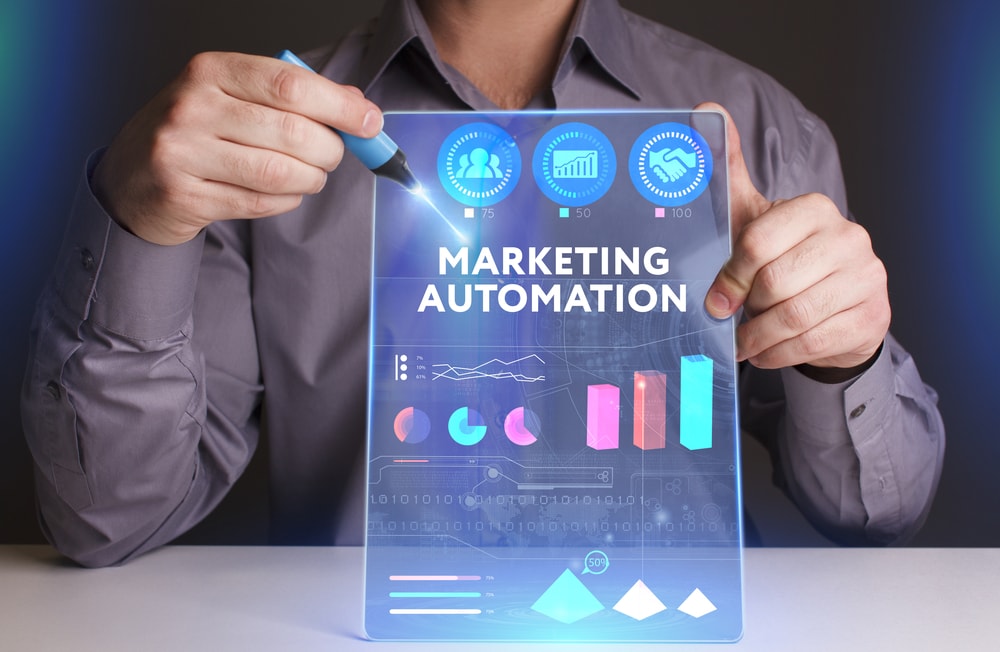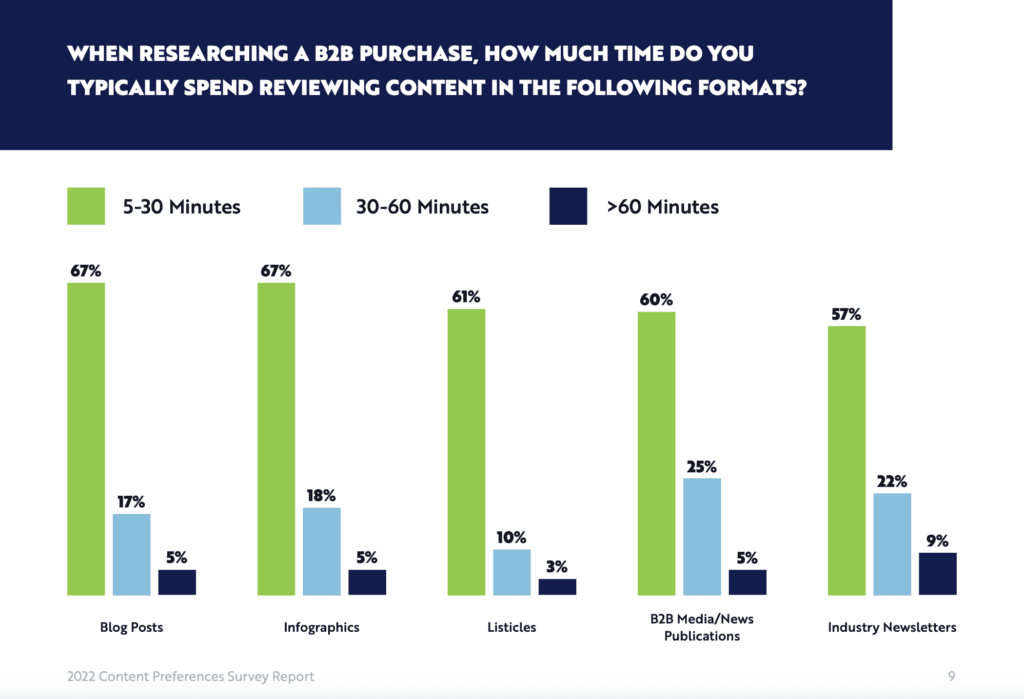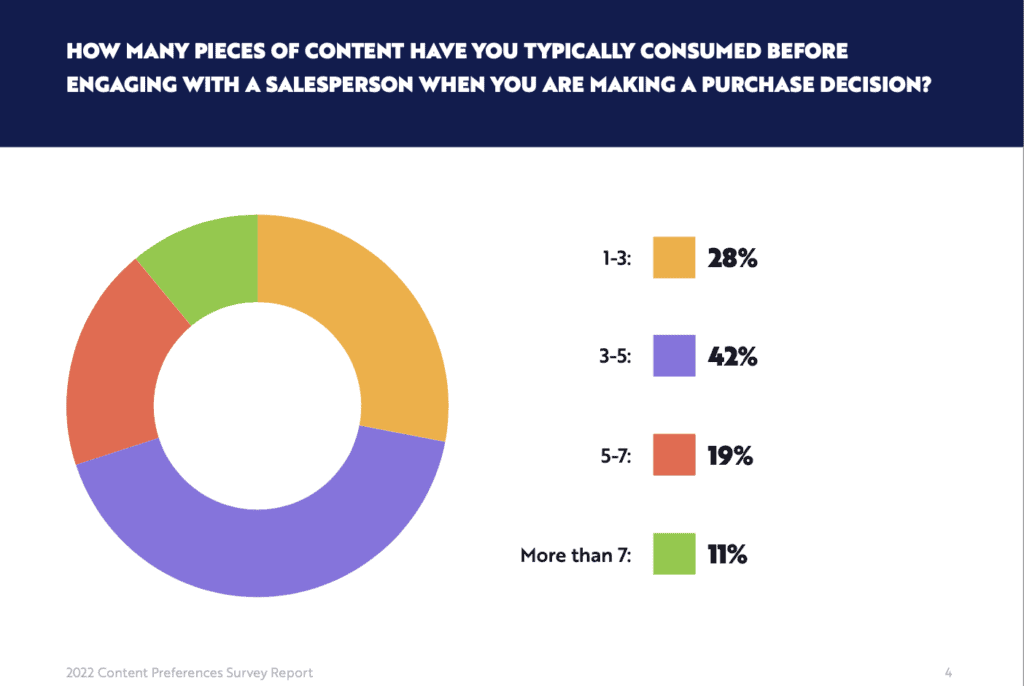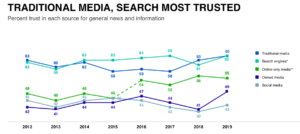
Top 100 Content Marketing Question: How do you think a marketing automation environment best supports content marketing?
Marketing automation supports content marketing by getting 4 jobs done for you:
- Track users’ interests to recommend relevant content streams.
- Assign scores to users to decide which are ready to contact and qualify.
- Offer content that helps buyers qualify themselves.
- Enable reverse engineering of successful content-to-customer conversions.
Track users’ content interests
Once buyers give you permission to track them on your website with a cookie, you can see exactly which content each buyer is most interested in.
Your marketing automation platform tracks the use of multiple touchpoints such as your social media, email, and website. So you get a more complete picture of how buyers interact with your content.
What’s working best for marketers who use marketing automation? Omnichannel studied 2 billion campaigns. They examined the impact of omnichannel marketing, compared segmented vs. non-segmented campaigns, studied campaign timing, and suggested best practices in subscriber list building.

Tracking reveals which:
- Topics are most relevant to a buyer.
- Media forms a buyer prefers – text, infographics, videos, podcasts?
- Media length a buyer prefers – short-form, medium or long-form content?
Companies that offer a broad array of products or services, in particular, benefit from the early identification of topics that are relevant to a given buyer. For example, in financial services, there are lots of different reasons why a customer might turn to a bank.

Marketing automation supports content marketing by identifying relevant topics for each buyer. The Bank of America website does this job brilliantly in five questions.
On Bank of America’s (BofA’s) website to improve financial literacy, BetterMoneyHabits.com, the company brilliantly unpacks one question, “What are your financial priorities?”
By asking five good questions, marketers identify detailed buyer personas.
Here are the five key questions:
- What stage of life are you in? Just starting out, working and growing, nearing retirement, or living in retirement?
- Tell us a little about your work situation: Working full-time, self-employed, currently a student, active military or a veteran, working part-time, not currently working?
- Which of these is most important to you? Building up savings, buying a home, improving credit, paying off student loans, reducing debt, or saving for college?
- Which of these is most relevant to you? Buying a car, getting married/living together, giving back/charity, moving, prepping for taxes, receiving a windfall, renting, starting a new job, traveling, welcoming a child?
- Lastly, are any of these relevant to you? Divorce, learning a new skill, leaving a legacy, losing a loved one, managing a job loss, managing healthcare costs, refinancing a home, starting a business, taking care of loved ones, teaching kids about money?
By capturing these 2 answers, BofA learns a user’s topics of interest so it can offer topic streams that are completely relevant to the user. All that work is done in 2 clicks!
Ask: How does your website steer users to relevant content? Does it help people ask the right questions?
Assign scores to content users
Marketing automation gives you visibility into what users are doing on your website.
At first, most users nibble at a piece of content here or there. They might or might not return to your site.
But a few website users will consume a ton of content quickly. When buyers are in a hurry, you need to flag them quickly for a follow-up call.
A DemandGen study found that a small number of B2B buyers will spend an hour or more on content. About one out of five will spend 30 to 60 minutes.
Buyers who are bingeing on content are the likeliest to convert into qualified leads.

Marketing automation supports content marketing by serving up the content buyers need.
Many buyers consume multiple pieces of content before talking to Sales, and DemandGen found out how many pieces of content B2B buyers consume in its 2022 study:

At a minimum, marketing automation should flag buyers who consume more than seven pieces of content over a short time period. This behavior isn’t mainstream, and there’s probably a motivated buyer behind it.
Webinars, e-books, research/survey reports, and blogs are the media B2B buyers most prefer, DemandGen found:

It’s worth picking up the phone to qualify such buyers. Some companies perform these calls through an inside sales function.
If your company doesn’t have inside sales, then your marketing demand generation manager needs to make these qualifying calls.
Find out buyers’:
- Intent to purchase … or other purposes?
- Is the budget available?
- Authority to buy?
- Needs that fit your offering?
- Timing – plans to buy now or later?
- How they found you in the first place?
After you call the buyers who consume seven pieces of content quickly, next flag buyers who consume 7 pieces of content gradually.
Add these buyers into a nurturing campaign to keep them engaged until they’re ready to take the next step. If you have the resources to do so, pick up the phone and call them.
For the buyers who have consumed 7 pieces of content, automatically offer them more content about their chosen topic(s) to nurture them along.
For all buyers, suggest related pieces of content that they have not seen yet about the same topic. Keep creating new content so that your most interested buyers have a reason to return to your website again and again.
Ask: How can you keep buyers engaged with a stream of relevant content over time? How can you refresh your content continuously to prevent it from going stale?
Qualify buyers with content

Here’s how the author and marketer Marcus Sheridan applied a smart idea at River Pools and Spas.
For years, he had called on prospective pool buyers at home before making a proposal to install a fiberglass pool. If you called for a proposal, Marcus visited you at home.
After Marcus created the industry’s best content on swimming pools, he changed the game. When a prospect called for a quote, Marcus sent them an email, inviting them to:
Watch a 3-minute video. And read a 35-page E-book about swimming pools.
Here’s what happened next. Buyers who did not consume this qualifying content, on average, bought a pool 5% of the time. Not a bad rate for swimming pools.
Buyers who did consume the qualifying content bought a pool 80% of the time. That’s a 16X improvement in close rates!
Why? After consuming that much content, a buyer either loves or hates the company, Marcus deduced.
Haters never called back. Haters saved valuable Sales time by eliminating the need to make follow-up calls.
If buyers loved the content, they became far more likely to sign a contract.
Quality over quantity
I learned this lesson the hard way in Marketing: it’s better to give Sales a small number of highly qualified buyers than a big number of unevenly qualified buyers.
If Sales have been ignoring your marketing-qualified leads, choke the bottom of the funnel – give them only one-fourth to one-half as many leads as before. Once you hear positive feedback from Sales about the lead quality and close rates, ease up on throttling the bottom of the funnel.
Ask: How can you use content to better qualify buyers before you hand them over to Sales? What’s the impact of content that helps Sales increase close rates?
Reverse-engineer conversions

After a year of experience with marketing automation, you will have gathered enough sales tracked from start to finish to find ideas on how to improve content marketing.
Match up your marketing automation metrics with Google Analytics and heat-mapping to learn:
- Which topics do buyers want more content on?
- Which pages are the best to offer to buyers first?
- How to smooth buyers’ paths by recommending the next pieces of content?
- Where do buyers get stuck?
- How to attain soft conversions – a small ask that precedes a bigger ask?
- How to get more buyers to subscribe to your blogs or content feed?
- What are the likeliest paths to conversion for buyers?
Doing this deep work with marketing automation analytics will help you map conversion paths to move buyers forward to a purchase.
To be sure, marketing automation offers many other benefits. It:
- Simplifies retargeting of users
- Helps build a content calendar
- Makes A/B email tests easier
- Updates other software systems such as sales automation automatically
- Enables personalization of marketing
- Generates reports to help you measure and prove content marketing success
- Is integrating artificial intelligence (AI) to bolster its capabilities..
Use marketing automation to do 4 key jobs for you:
- Track users’ interests to recommend relevant content streams.
- Assign scores to users to decide which are ready to contact and qualify.
- Offer content that helps buyers qualify themselves.
- Enable reverse engineering of successful content-to-customer conversions.
Strategically turning content users into customers is what #contentmarketing is all about!

“How do you think a marketing automation environment best supports content marketing?” is one of marketers’ Top 100 Questions about #contentmarketing. Here are the answers.





